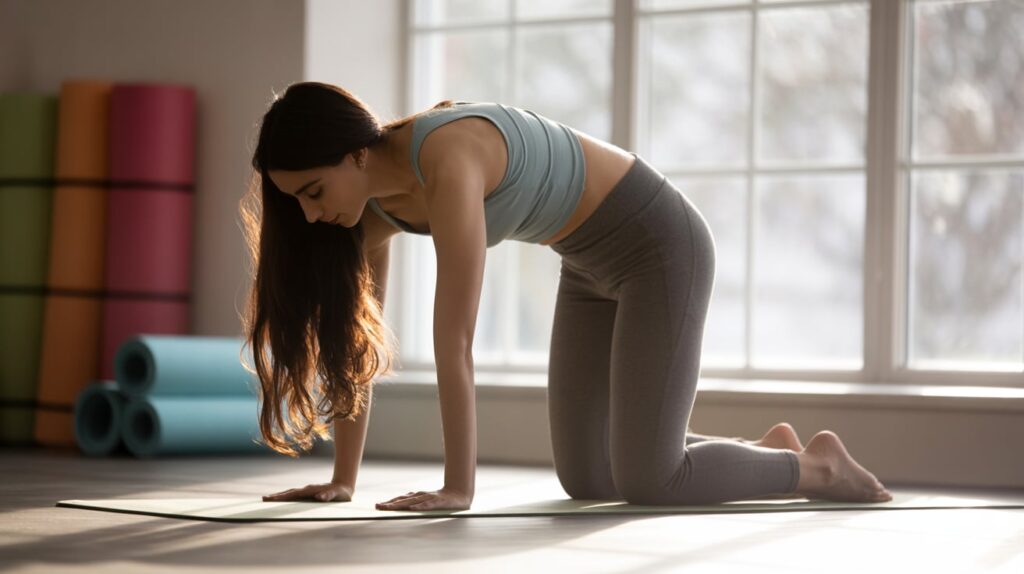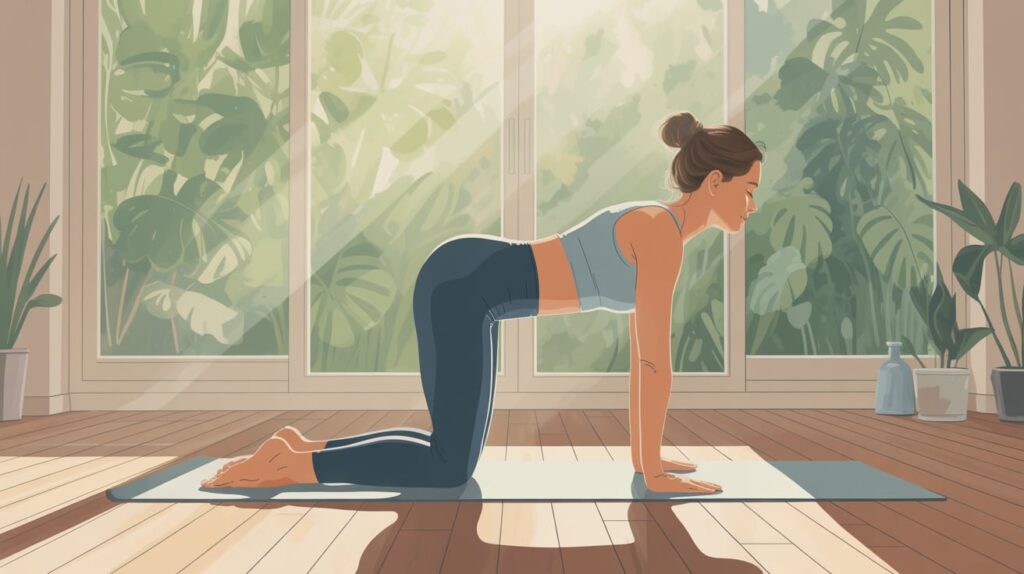Are you tired of living with lower back pain that disrupts your daily life? Can simple stretches and movements provide relief?
Millions of people worldwide suffer from lower back pain, which affects their well-being and productivity. Yoga is a popular and effective solution. It offers a holistic approach to alleviating discomfort and promoting spinal health.

This article explores the most effective yoga stretches for lower back pain relief. It provides a comprehensive guide to managing and preventing discomfort.
Key Takeaways
- Discover the benefits of yoga for lower back pain relief
- Learn the most effective lower back stretches to alleviate discomfort
- Understand how to incorporate yoga into your daily routine for spinal health
- Explore the connection between yoga and back pain management
- Find relief from lower back pain with simple and accessible yoga poses
Understanding Lower Back Pain and How Yoga Helps
Lower back pain is a common problem that affects many people. It can make daily life hard and affect overall health. It’s important to know why it happens and how yoga can help.
Common Causes of Lower Back Pain
Many things can cause lower back pain. These include poor posture, muscle strain, herniated discs, and degenerative diseases. The American Chiropractic Association says about 80% of adults will have lower back pain at some point. Knowing the causes helps find the best treatment.

The Science Behind Yoga for Back Pain Relief
Yoga is known to help with lower back pain. It combines physical poses, breathing, and meditation for better health. Studies show yoga can reduce pain, improve function, and enhance quality of life for those with back pain. A Journal of the American Medical Association study found yoga helps lower back pain and improves function.
“Yoga is known for its ability to ease lower back pain by enhancing flexibility, strengthening muscles, and improving posture.”
Benefits of Regular Yoga Practice for Back Health
Yoga offers many benefits for back health. It can increase flexibility, strengthen back muscles, and improve posture. It also helps manage stress, which can cause back pain. Here are some benefits of yoga for back health.
| Benefit | Description |
| Increased Flexibility | Yoga stretches and lengthens muscles, improving flexibility and reducing stiffness. |
| Strengthened Back Muscles | Yoga poses strengthen back muscles, providing better spine support. |
| Improved Posture | Yoga strengthens core and back muscles, improving posture and reducing lower back strain. |
Best Yoga Poses for Lower Back Pain Relief
Gentle yoga poses can help a lot with lower back pain. These poses are easy on the body and help ease discomfort. They also help your back heal.
Child’s Pose (Balasana)
Child’s Pose is a basic yoga pose. It stretches the lower back and helps you relax.
Step-by-Step Instructions
- Kneel on the mat with your knees wide apart.
- Sit back onto your heels.
- Stretch your arms out in front of you.
- Lower your forehead to the ground, breathing deeply.
Benefits for the Lower Back
Child’s Pose stretches the spine and eases lower back tension. It also makes you feel calm and relaxed, reducing stress and pain.
Cat-Cow Stretch (Marjaryasana-Bitilasana)
The Cat-Cow Stretch is a gentle flow that warms the spine and eases tension.
Step-by-Step Instructions
- Start on your hands and knees.
- Inhale, arching your back and lifting your tailbone (Cat Pose).
- Exhale, rounding your back and tucking your chin to your chest (Cow Pose).
- Repeat, moving slowly.
Benefits for the Lower Back
This stretch boosts spine flexibility and reduces stiffness. It helps relieve lower back pain.
Downward-Facing Dog (Adho Mukha Svanasana)
Downward-Facing Dog is a foundational standing pose. It stretches the back side of the body.
Step-by-Step Instructions
- Start on your hands and knees.
- Walk your hands forward.
- Lift your hips up and back, straightening your arms and legs.
- Keep your head in a neutral position.
Benefits for the Lower Back
Downward-Facing Dog stretches the hamstrings and calves. This helps ease lower back tension. It also strengthens the arms and legs.
Sphinx Pose (Salamba Bhujangasana)
Sphinx Pose is a gentle backbend. It strengthens the back muscles and opens the chest.
Step-by-Step Instructions
- Lie on your stomach with your forearms on the ground.
- Press your forearms down and lift your chest and head off the mat.
- Keep your shoulders down and away from your ears.
Benefits for the Lower Back
Sphinx Pose strengthens the back muscles. This improves posture and reduces lower back pain. It also opens the chest, enhancing breathing.
Bridge Pose (Setu Bandha Sarvangasana)
Bridge Pose is a gentle backbend. It strengthens the back and glutes.
Step-by-Step Instructions
- Lie on your back with your knees bent and feet flat on the ground.
- Press your feet into the ground and lift your hips.
- Squeeze your glutes at the top.
Benefits for the Lower Back
Bridge Pose strengthens the lower back and glutes. This helps stabilize and support the spine.
Supine Twist (Supta Matsyendrasana)
Supine Twist is a gentle pose. It stretches the spine and hips.
Step-by-Step Instructions
- Lie on your back with your knees bent.
- Let your knees fall to one side.
- Turn your head to the opposite side.
Benefits for the Lower Back
Supine Twist stretches the spine and hips. This relieves tension and improves flexibility.
Pigeon Pose (Eka Pada Rajakapotasana)
Pigeon Pose is a deep hip opener. It helps ease lower back tension.
Step-by-Step Instructions
- Start on your hands and knees.
- Bring one knee forward and place your foot on the ground before the other knee.
- Lower your hips down towards the ground.
Benefits for the Lower Back
Pigeon Pose stretches the hips and glutes. This reduces lower back tension. It also promotes flexibility and relaxation.
Proper Technique and Safety Guidelines
When you practice yoga for lower back pain, focus on the right technique and safety. As you try out different yoga poses for lower back pain, knowing how to practice safely is key.
Essential Alignment Principles
Getting your body’s alignment right is the first step to safe and effective yoga. Paying attention to how your body is positioned in each pose helps avoid injuries. For example, in poses like

Engaging your core and keeping your spine aligned can greatly reduce lower back strain. As you try different poses, listen to your body and adjust your alignment as needed.
Modifications for Different Pain Levels
Everyone feels pain differently, and yoga needs to be adjusted for you. If you have severe pain, start with easier poses. Using a strap or block can help keep your pose right without too much strain.
As you get more comfortable, try more challenging poses. Choose ones that match your flexibility and pain level.
When to Consult a Healthcare Provider
Yoga is usually safe, but sometimes you should talk to a healthcare provider first. If you feel sharp pain, numbness, or tingling, get medical advice.
“Yoga should be practiced with awareness and caution, especially when dealing with injuries or chronic conditions like lower back pain.”
By listening to your body and taking the right precautions, you can enjoy yoga’s benefits for lower back pain. This way, you can minimize risks.
Creating a Lower Back Pain Relief Yoga Sequence
A well-structured yoga sequence can greatly reduce lower back pain and boost your overall health. It’s important to make the sequence fit your needs. Whether you need quick relief or a full practice, there’s a way to make it work for you.
10-Minute Quick Relief Routine
If you’re short on time, a 10-minute routine can help with lower back pain. This quick sequence includes poses like Child’s Pose (Balasana), Cat-Cow Stretch (Marjaryasana-Bitilasana), and Sphinx Pose (Salamba Bhujangasana). These poses gently stretch and relax your lower back.
- Start with Child’s Pose to stretch the back and relax the muscles.
- Then, do Cat-Cow Stretch to warm up your spine.
- Finish with Sphinx Pose to strengthen your back muscles.
20-Minute Daily Practice
A 20-minute daily practice offers a deeper approach to relieving lower back pain. You can add poses like Downward-Facing Dog (Adho Mukha Svanasana) and Bridge Pose (Setu Bandha Sarvangasana) to improve flexibility and strength.
- Begin with gentle stretches like Child’s Pose and Cat-Cow Stretch.
- Next, do Downward-Facing Dog to stretch your backside.
- Then, do Bridge Pose to strengthen your back and glutes.
- End with Sphinx Pose for final relaxation.
30-Minute Complete Back Care Sequence
A 30-minute sequence is perfect for a full back care practice. You can include various poses to tackle different parts of lower back pain.

This sequence might include Pigeon Pose (Eka Pada Rajakapotasana) for hip flexibility and Supine Twist (Supta Matsyendrasana) for spinal rotation.
Incorporating Props for Enhanced Support
Using props can make your yoga practice more comfortable and supportive. Blocks, straps, and blankets help keep you in the right position and ease strain on your lower back.
- Use a block to support your back in Bridge Pose.
- Employ a strap to deepen your stretch in Seated Forward Fold.
- Place a blanket under your knees for comfort in Child’s Pose.
Conclusion
Yoga can change your life if you have lower back pain. Adding yoga stretches to your day can make a big difference. It’s a step towards feeling better overall.
Poses like Child’s Pose and Cat-Cow Stretch can ease tension and boost flexibility. These yoga poses are key to keeping your back healthy. They work well when done right.
As you keep practicing yoga, you’ll notice big changes. Your lower back will feel better, and so will your body and mind. Yoga is a great way to start living without pain. It brings many benefits to your life.
FAQ
What are the best yoga poses for lower back pain relief?
The top yoga poses for lower back pain include Child’s Pose and Cat-Cow Stretch. Downward-Facing Dog and Sphinx Pose are also great. Bridge Pose, Supine Twist, and Pigeon Pose round out the list. These poses stretch and strengthen the lower back, improving flexibility and reducing tension.
How does yoga help alleviate lower back pain?
Yoga eases lower back pain by stretching and strengthening muscles. It boosts flexibility and cuts down on tension. It also promotes good posture, lowers stress, and enhances back health overall.
Can yoga be used as a treatment for chronic lower back pain?
Yes, yoga is a good treatment for chronic lower back pain. Studies show it can lessen pain and improve function in those with chronic pain.
What is the best yoga sequence for lower back pain relief?
A good yoga sequence for lower back pain includes gentle stretches, strengthening poses, and relaxation. A 10-minute quick relief routine or a 20-minute daily practice can help. Tailor it to your needs with a 30-minute complete back care sequence.
Are there any safety guidelines to follow when practicing yoga for lower back pain relief?
Yes, it’s crucial to follow safety guidelines when doing yoga for lower back pain. Learn essential alignment, modify poses for your pain level, and get a healthcare provider’s advice when needed.
Can props be used to enhance support in yoga for lower back pain relief?
Yes, props like blocks, blankets, and bolsters can help support and modify poses. They make yoga more accessible and comfortable for those with lower back pain.
How often should I practice yoga for lower back pain relief?
How often to practice yoga for lower back pain depends on your needs and goals. Aim for 2-3 times a week. Regular practice can reduce pain and improve back health.
